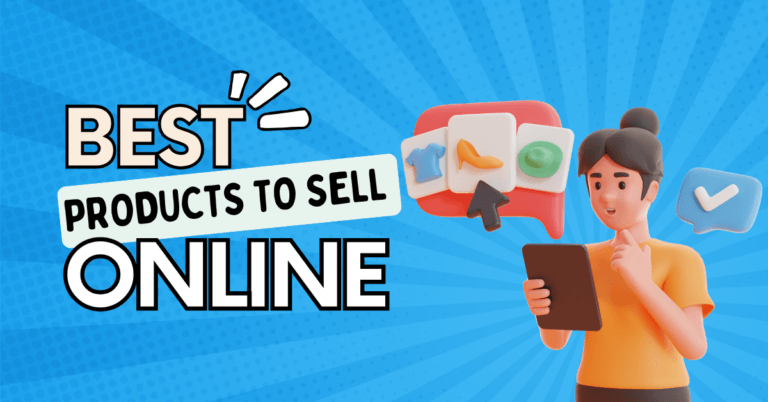How To Sell Handmade Products Online
How To Sell Handmade Products Online
How to sell handmade products online is a question many creative entrepreneurs are asking today. With the rise of eCommerce, turning your handmade goods into a thriving business is more achievable than ever.
This blog will walk you through everything you need to know—from setting up an online store to marketing your unique creations—so you can successfully sell handmade products online and confidently grow your brand.
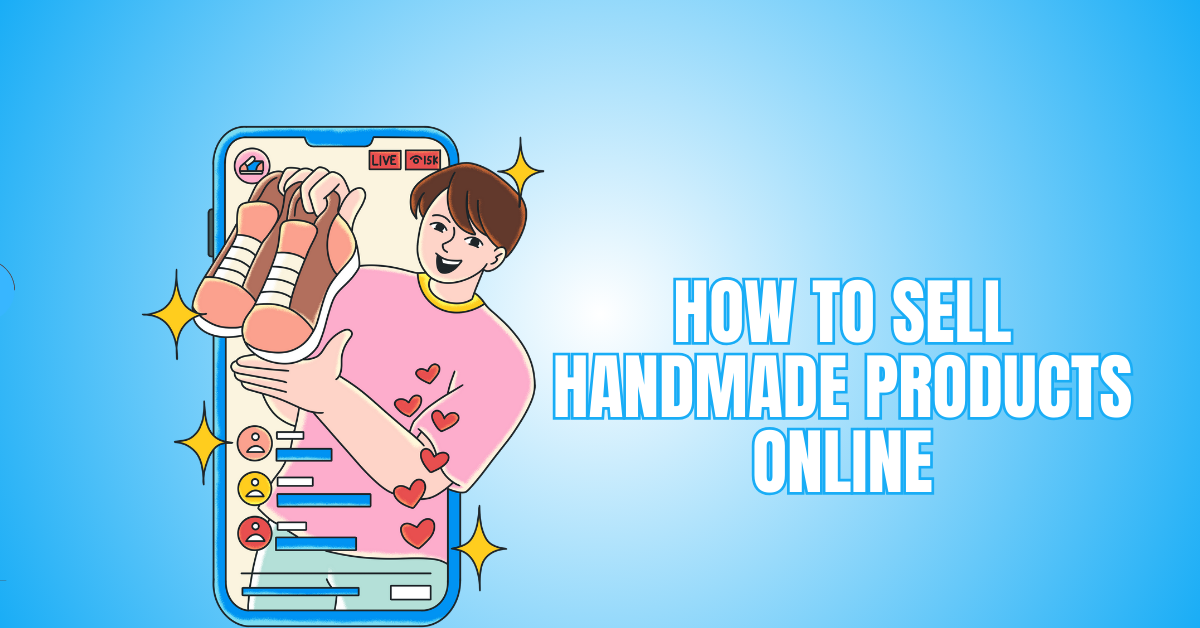
Best Handmade Products To Sell Online
Here are some of the best handmade products to sell online, based on demand, uniqueness, and profitability:
1. Handmade Jewelry
Craft personalized necklaces, bracelets, rings, or earrings with resin, beads, or wire. Unique and custom designs attract buyers looking for meaningful accessories.
Popular on Etsy, handmade jewelry can earn from $20 to $200+ per piece, depending on materials and complexity, making it a lucrative online business.
2. Candles
Make soy, beeswax, or scented candles in attractive containers. Eco-friendly and aromatherapy candles are highly sought after for gifts and home ambiance.
Candles typically sell between $10 and $50 each, with potential monthly earnings reaching several thousand dollars when scaled effectively through social media and online shops.
3. Soap & Bath Bombs
Create organic or vegan soaps and bath bombs with unique scents and shapes. These self-care products cater to wellness trends and make great gifts.
Want to Start Making Money Online?
Try My #1 Recommendation Program!
Handmade soaps can sell for $5 to $20, with bath bombs earning $3 to $10 each, enabling steady income with proper marketing.
4. Home Décor Items
Produce macramé wall hangings, pottery, or hand-painted signs that complement boho or rustic interiors. These decorative pieces command prices from $30 to $150 or more. Successful sellers can generate $500 to $3,000 monthly, depending on product variety and customer reach.
5. Knitted Or Crocheted Goods
Make scarves, hats, blankets, or baby clothes with custom colours and designs—handmade knitwear appeals especially during colder seasons, with prices ranging from $25 to $100. Dedicated crafters can earn between $500 and $2,000 monthly through consistent sales and seasonal promotions.
6. Artwork & Prints
Sell original paintings, illustrations, or digital art downloads. Unique handmade art decorates homes and offices, with originals fetching $50 to $1,000+ and prints selling for $10 to $50. Artists can scale income via digital products, earning $1,000+ monthly with a strong audience.
7. Customized Stationery
Design journals, planners, greeting cards, or wedding invitations with personalized details. Handmade stationery appeals to event planners and stationery lovers, selling from $5 to $50 per item. Depending on custom order volume and marketing, successful shops can earn $500 to $2,500 monthly.
8. Handmade Bags & Accessories
Create tote bags, wallets, or pouches from fabric, leather, or crochet. Sustainable and stylish, these items sell from $20 to $150 each.
Growing eco-conscious markets enable crafters to generate $1,000 to $4,000 monthly by targeting niche fashion audiences.
9. Pet Accessories
Craft collars, bandanas, and pet toys, often personalized or themed. Pet owners will spend $10 to $60 per item for quality handmade products. With strong branding, sellers can earn $500 to $2,000 monthly in this expanding pet niche.
10. Handmade Clothing
Produce baby clothes, tie-dye shirts, or upcycled fashion pieces. Handmade apparel offers uniqueness, often selling from $20 to $150 depending on design and materials.
Skilled sellers focusing on custom sizing and exclusive styles can earn $1,000+ monthly by reaching targeted customers online.
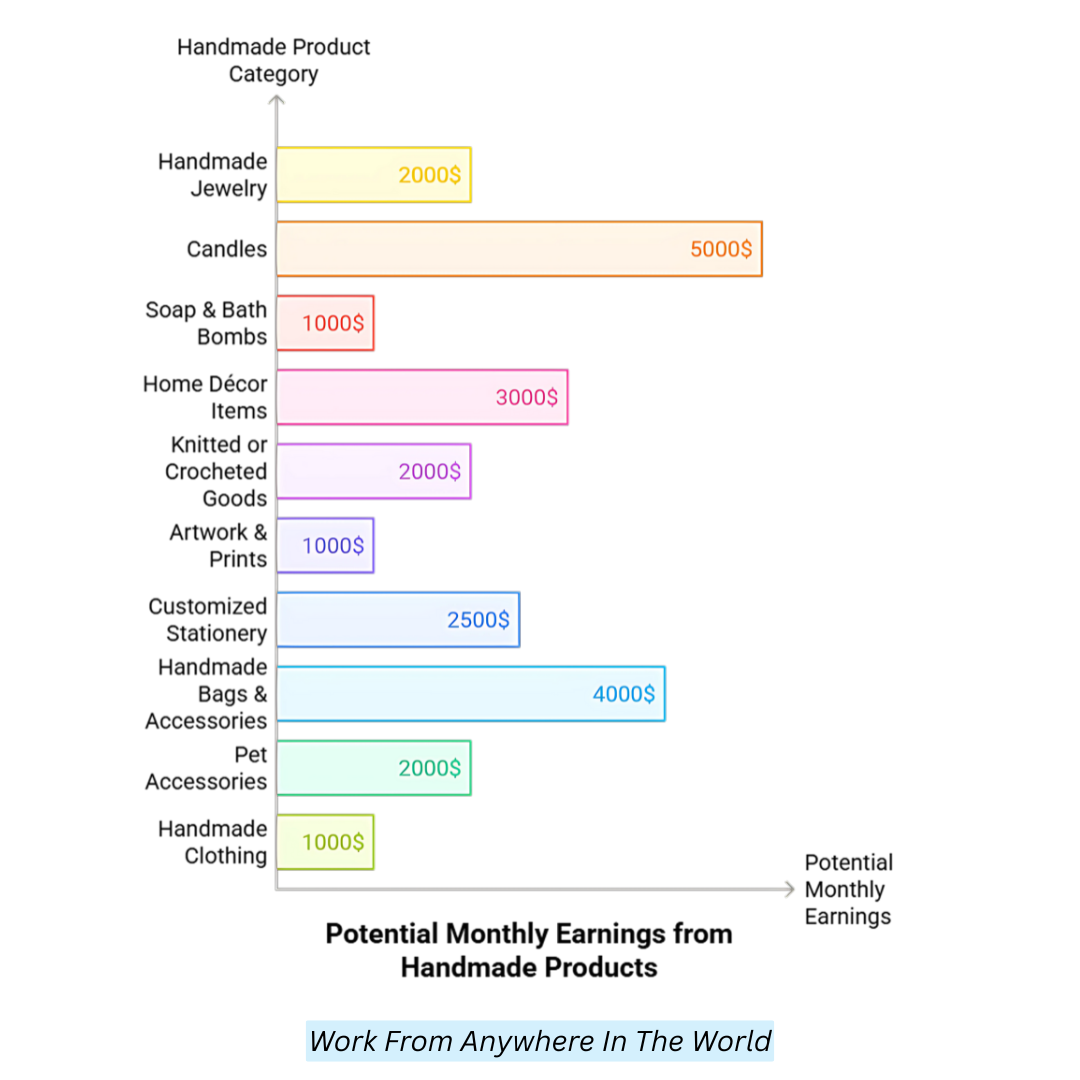
How To Sell Handmade Products Online
1. Identify Your Niche And Product Line
Identifying your niche is the first step to successfully selling handmade products online. A niche helps define what makes your products unique and who they are for.
Think about your hobbies, talents, and the kinds of handcrafted goods you like making to start. Then, research current trends using tools like Google Trends, Etsy’s search bar, or Ubersuggest to gauge demand.
Want to Find Out How To Start Your Home-Based Business?
Try My #1 Recommendation Platform!
Consider your target audience—are they eco-conscious shoppers, pet owners, or minimalist decor lovers? Study your competitors and look for gaps you can fill. Instead of selling generic items, offer something specific, like hand-poured soy candles for yoga enthusiasts.
Keep your product line focused with a consistent theme and style to strengthen your brand identity and attract loyal customers.
Key Points
- Research market demand with tools like Google Trends, Etsy search, and Ubersuggest
- Define your ideal customer
- Study competitors to find a unique angle
- Start with a small, cohesive product line
2. Set Up Your Business Legally
Setting up your handmade business legally is essential for smooth operations, protecting your assets, and preparing for future growth.
Selecting a distinctive company name that captures your brand identity should be your first step. Check domain availability and register the name locally.
Next, choose a legal structure such as a sole proprietorship, LLC, or partnership—each has different liability and tax implications.
In the U.S., register your business through your state’s Secretary of State website. For tax purposes, apply for an Employer Identification Number (EIN) on IRS.gov.
You may also need crafting or sales permits depending on your location. To keep finances apart, open a company bank account.
For added protection, consider trademarking your logo or product names. Services like LegalZoom and ZenBusiness can simplify the process.
Staying compliant boosts professionalism, enables access to grants or wholesale opportunities, and builds customer credibility.
Key Points
- Choose and register a business name
- Select a legal structure (LLC, sole proprietorship, etc.)
- Apply for licenses, EIN, and permits
- Separate personal and business finances
3. Price Your Products For Profit
Pricing handmade products requires a thoughtful approach that ensures profit while staying competitive. Use the basic formula: (Materials + Time) × Markup + Overhead = Retail Price.
Begin by calculating the exact cost of materials per item, including small details like beads or labels. Assign a fair hourly rate for your time and track how long each product takes to make. Include all overhead expenses—website fees, packaging, tools, studio space, and marketing.
Apply a markup (typically 2–3x) to secure a sustainable profit—study competitor pricing on platforms like Etsy to align with market standards. Avoid underpricing, as it undervalues your work.
Tools like Craftybase or HandmadePricingCalculator.com can help. Offer tiered pricing or bundles to reach different buyers. Regularly adjust pricing based on expenses and demand.
Key Points
- Use a pricing formula: (Materials + Time) × Markup + Overhead
- Factor in labour, packaging, and transaction fees
- Use tools like Craftybase or HandmadePricingCalculator
- Offer bundles or tiered pricing
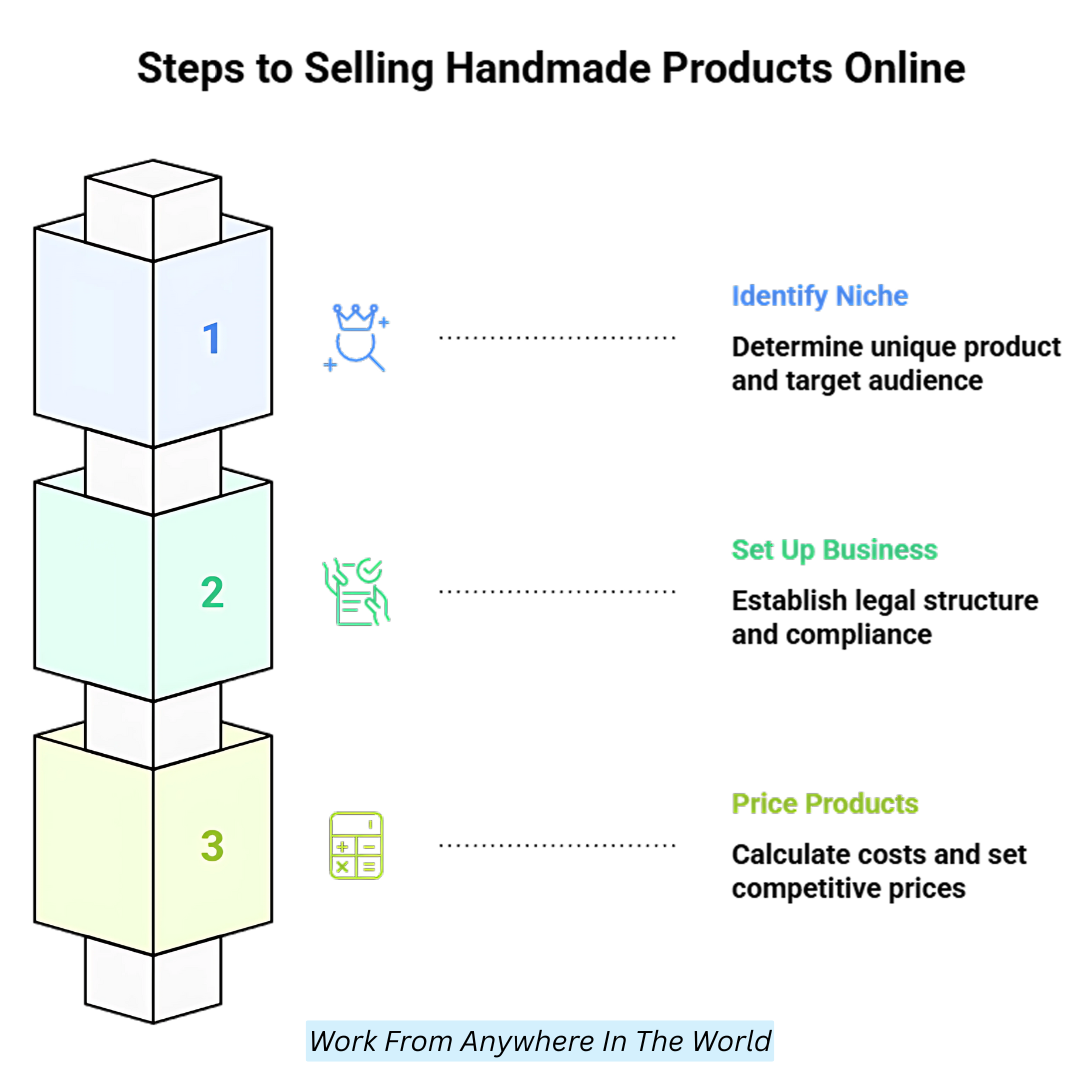
4. Choose The Right Online Platform
Choosing the right platform to sell handmade items is crucial for visibility, control, and profitability. Start by comparing popular platforms.
Etsy is fantastic for beginners, offering built-in traffic and a handmade-focused audience. Shopify is best for those who want complete control over branding, customization, and analytics. Amazon Handmade provides a vast reach but has a strict application process and higher fees.
Enormous Cartel is budget-friendly and works well for artists with a small product line. Social platforms like Instagram and Facebook Shops allow you to sell directly using engaging visuals and messaging.
You can also create your site using Wix, Squarespace, or WordPress with WooCommerce. Consider fees, SEO, customization, and growth potential.
Visit Etsy.com/sell, Shopify.com, and Amazon.com/handmade to explore options. Start with one platform, master it, then expand.
Key Points
- Start with one central platform: Etsy, Shopify, or Amazon Handmade
- Evaluate fees, features, and ease of use
- Build a personal site using Wix, Squarespace, or WooCommerce
- Expand to social media and multi-channel selling
5. Take Stunning Product Photos
Stunning product photos are vital for online success, as they build trust and drive sales. Since buyers can’t physically touch your items, visuals must convey quality.
Use a high-resolution camera or a modern smartphone with a sharp lens. Shoot in natural light to minimize shadows and bring out true colours.
Choose a clean, clutter-free background—white backdrops create a professional look. Photograph your product from multiple angles, including close-ups and lifestyle shots, to show how it’s used.
Are You Tired Of Scams?
Want to Start Making Money Online?
Props should enhance, not overpower. Include a hand or an everyday object for size reference. Edit photos for clarity using free tools like Canva or Adobe Lightroom Mobile.
Consistent photography across listings reinforces your brand. Consider a lightbox for better lighting. High-quality, clear photos significantly boost engagement, trust, and conversions.
Key Points
- Use natural lighting and simple backdrops
- Show multiple angles and product use
- Use editing tools like Canva or Lightroom Mobile
- Keep a consistent photography style
6. Write Compelling Product Descriptions
Compelling product descriptions are key to converting browsers into buyers. Start with a clear, attention-grabbing headline that immediately telling customers what the item is.
In the opening lines, highlight key benefits and what makes your product special—mention materials, handmade techniques, or eco-friendly sourcing.
Follow with detailed specs: size, weight, colours, care instructions, and customization options. Use bullet points to improve readability.
Add a brief story if it enhances the connection, such as the inspiration behind the design. Use sensory-rich words like “velvety,” “fragrant,” or “sleek” to help customers imagine the product.
Naturally, include relevant keywords for SEO—tools like Marmalead or eRank are helpful for Etsy sellers. Avoid technical jargon and keep your brand voice consistent. A great description informs, excites, and builds trust.
Key Points
- Start with benefits and unique features
- List details like size, materials, and care
- Use SEO keywords naturally
- Maintain brand tone and clarity
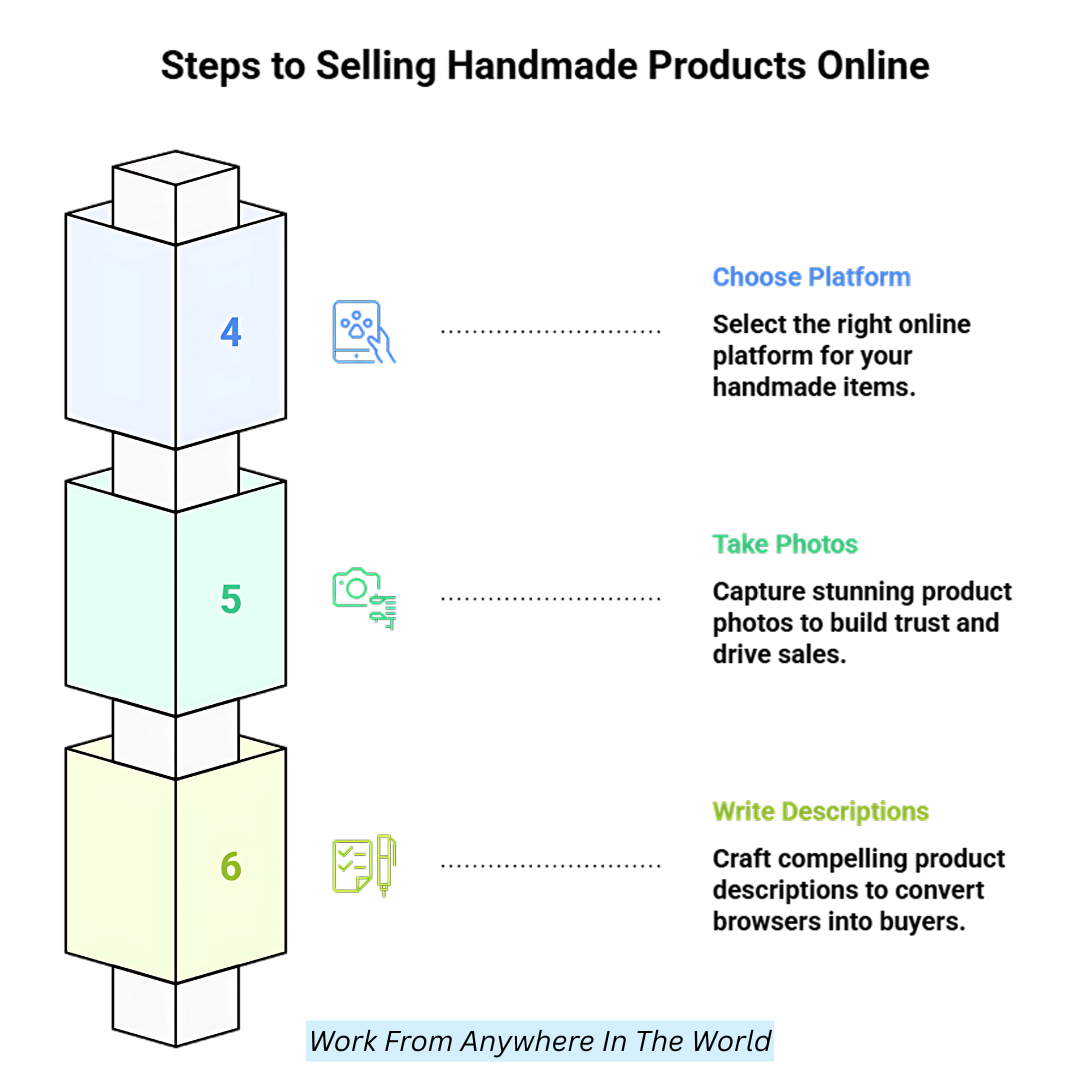
7. Set Up Payment And Shipping Methods
A seamless payment and shipping process is vital for customer satisfaction and business efficiency. Start by integrating secure payment gateways like PayPal, Stripe, or platform-specific tools like Etsy or Shopify Payments.
Popular options include credit/debit cards, Apple Pay, and Google Pay. Ensure your website has an SSL certification to protect customer data. For shipping, determine package dimensions and weight, then calculate accurate rates using USPS, FedEx, or UPS tools.
Provide multiple delivery speeds to suit buyer needs. Use Pirate Ship or ShipStation to print discounted labels and manage tracking.
Clearly state your shipping policies, processing times, and fees on product pages. Opt for eco-friendly or branded packaging for a professional touch.
Always provide tracking info and updates. Understand customs rules for international shipping. Automate where possible to save time. Reliable, clear payment and shipping practices build trust and increase customer retention.
Key Points
- Use SSL certificates for data protection
- Offer multiple shipping speed options
- Use branded or eco-friendly packaging
- Provide tracking and clear shipping policies
8. Brand Your Business
Branding is what distinguishes your handmade business in a saturated market. Begin by defining your brand identity—what mission drives you, what values you uphold, and the story behind your creations.
Choose a business name and tagline that emotionally connect with your target audience. Create a logo using tools like Canva, Looka, or Hatchful by Shopify.
Establish a cohesive visual identity with consistent colours, fonts, and styles across all platforms—website, packaging, and social media.
Want To Learn How To Create Your Own Website And Online Business?
Try My #1 Recommendation Training And Hosting Platform!
Develop a brand voice that reflects your niche—rustic, elegant, quirky, or minimalist. Enhance packaging with custom stickers, thank-you notes, or eco-friendly materials to elevate the unboxing experience.
Share behind-the-scenes content on Instagram, TikTok, or your blog to deepen engagement. Consistency in visuals, messaging, and service builds trust and brand loyalty. Your brand is your story—tell it with heart.
Key Points
- Create a memorable name, tagline, and logo
- Choose consistent colours, fonts, and style
- Develop a matching brand voice
- Share behind-the-scenes content
9. Promote Your Products Online
Effective promotion is essential for attracting traffic and boosting sales. Start with organic methods. Create an Instagram business profile and post consistently—highlight products, share making-of videos, customer reviews, and seasonal content.
Use 5–10 relevant hashtags to increase reach. Pin high-quality images on Pinterest with links to your store. Join crafting or local buy-and-sell groups on Facebook, and use TikTok to share fun, behind-the-scenes videos of your process.
Build an email list with tools like MailerLite, ConvertKit, or Klaviyo—offer a discount for sign-ups and send newsletters with updates, stories, and promos.
Collaborate with niche micro-influencers for product features or giveaways. Once established, explore paid ads—use Meta Ads (Facebook & Instagram), Etsy Ads, or Google Ads to reach target audiences.
Track analytics and refine your approach. Combining free and paid marketing strategies consistently increases visibility and long-term growth.
Key Points
- Use organic social media (Instagram, Pinterest, TikTok) daily
- Build an email list with signup incentives
- Collaborate with influencers and bloggers
- Invest in targeted paid advertising
- Monitor analytics and adjust campaigns
- Mix free and paid promotion methods
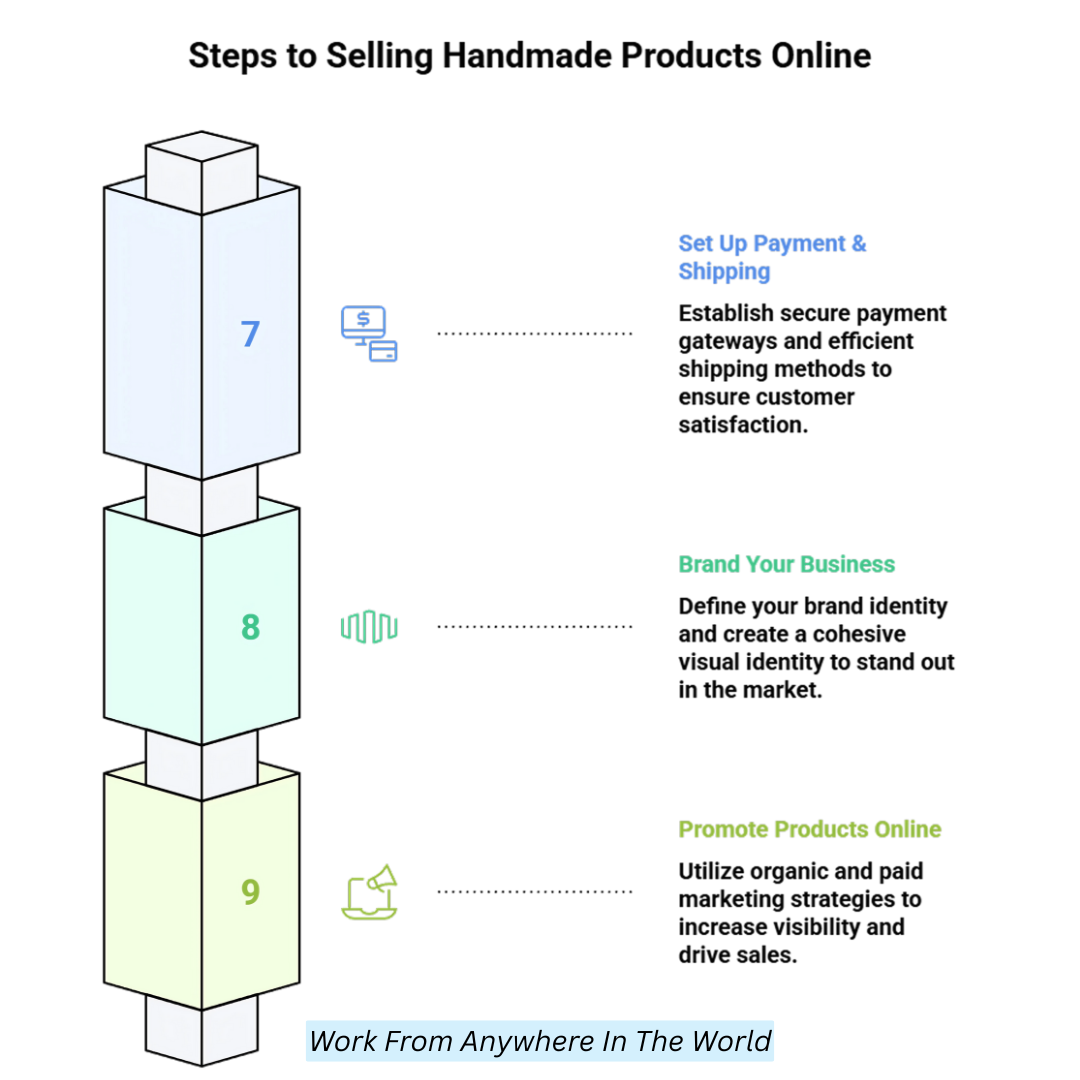
10. Deliver Excellent Customer Service
Encouraging repeat business and word-of-mouth referrals requires exceptional customer care. Start by writing honest, detailed product listings to manage expectations.
Respond to customer inquiries within 24 hours using warm, professional language. Keep buyers informed with updates on order status and tracking details.
Handle issues—like delays or damages—promptly with solutions such as refunds, replacements, or store credits. Use tools like Shopify Inbox, Zendesk, or Etsy’s messaging system for smooth communication.
Include care instructions and thank-you cards with parcels to give them a personalized touch. After delivery, follow up and kindly request reviews.
Emphasize encouraging comments on your website or social media pages. Address criticism with grace and use it to refine your business.
Build an FAQ page to answer common questions. Thoughtful, consistent customer service builds trust, encourages repeat purchases, and turns happy buyers into loyal brand ambassadors.
Key Points
- Proactively update customers on orders
- Resolve problems promptly and fairly
- Personalize packaging with thank-you notes
- Encourage and showcase customer reviews
- Use the FAQ to reduce common questions
11. Track Your Progress And Optimize
Tracking your business performance helps identify strengths and areas to improve. Use Etsy, Shopify, or Google Analytics tools to monitor traffic sources, conversion rates, sales trends, and customer behaviour.
Google Search Console can track your SEO progress. Set clear KPIs like monthly revenue or email list growth. Use inventory tools such as Craftybase or QuickBooks Commerce to manage stock and costs.
A/B test product titles, descriptions, and images to find what converts best. Analyze which marketing campaigns drive traffic and focus on replicating their success.
Regularly review your product range—remove slow sellers and expand the best sellers. Consistent data analysis enables smart decisions, improves profitability, and supports sustainable business growth.
Key Points
- Use built-in analytics and Google Search Console
- Monitor KPIs like revenue and subscriber growth
- Manage inventory with specialized tools
- A/B test product listings and marketing
- Analyze campaigns to replicate success
- Review and adjust the product lineup regularly
12. Scale Your Business
Scaling your handmade business means growing sustainably and efficiently. Start by expanding your product line with variations, seasonal items, or complementary products.
Explore wholesaling by contacting local boutiques or online platforms like Faire and Handshake. Create subscription boxes or bundles for steady income.
Outsource repetitive tasks such as packaging, social media, or bookkeeping via Fiverr or Upwork. Use tools like Inventory Planner, ShipStation, and Zoho Inventory to streamline operations.
Hire part-time help or collaborate with other makers. Improve efficiency by batching production and organizing your workspace.
Consider crowdfunding on Kickstarter to launch new products. Attend craft fairs and trade shows to broaden your audience. Scaling smartly means systematizing your growth processes while preserving your brand’s artisanal charm.
Key Points
- Expand product range and add variations
- Explore wholesaling and subscription models
- Use tools to streamline inventory and shipping
- Hire help or collaborate with makers
- Batch production and organize the workspace
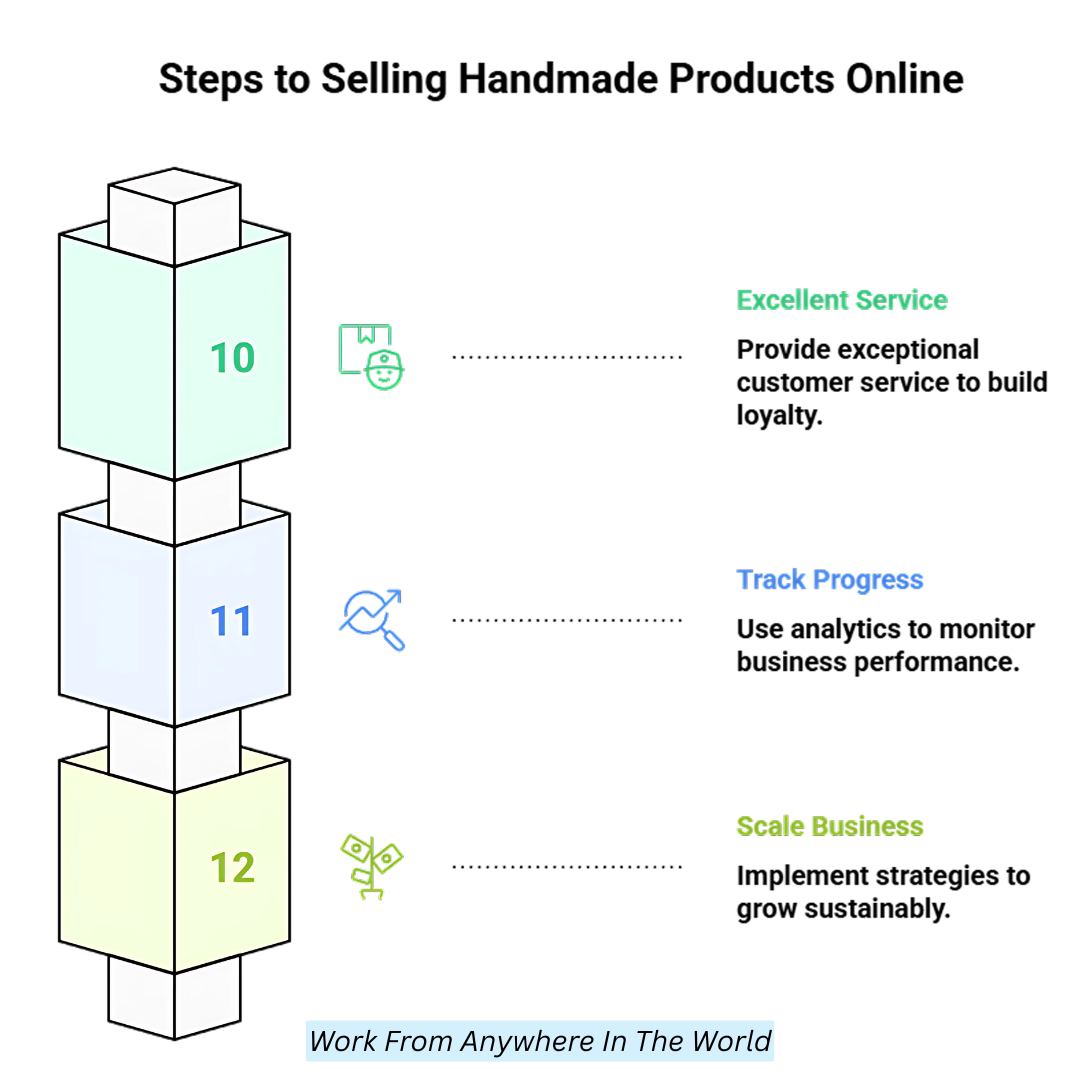
Conclusion
Selling handmade products online is a rewarding journey that blends creativity with entrepreneurship. You can turn your passion into profit by following the proper steps—from choosing the right platform to marketing effectively.
Now that you know how to sell handmade products online, it's time to take action, share your creations with the world, and build a thriving business doing what you love. Start today and let your handmade brand shine online.
I trust you enjoyed this article about How To Sell Handmade Products Online. Please stay tuned for more articles. Take care!
JeannetteZ
Want to Learn How to Build Your Own Home-Based Online Business And Start Making Money Online From Your Comfortable Couch?
Try Wealthy Affiliate!
Your Opinion Is Important To Me
Do you have thoughts, ideas, or questions? I would love to hear from you. Please share your questions, experiences, remarks, and suggestions about How To Sell Handmade Products Online in the comments below. You can also email me at Jeannette@WorkFromAnywhereInTheWorld.com.
Disclosure
This post may contain affiliate links. I earn from qualifying purchases as an Amazon Associate and through other affiliate programs. Please read my full affiliate disclosure.
You may also enjoy the following articles:
Wealthy Affiliate Coupons For Premium Memberships
Wealthy Affiliate Review – Scam or Legit? The Truth Exposed
An Insider Wealthy Affiliate Review
How To Make Money On A Food Blog
How To Start A Sports Blog And Turn Passion Into Profit
How To Create A Landing Page In SquareSpace
Top-Rated Examples Of eCommerce Businesses You’ll Love Exploring



